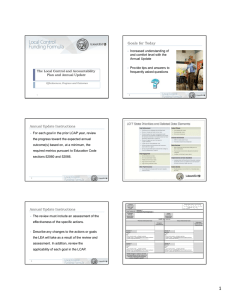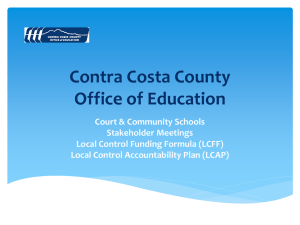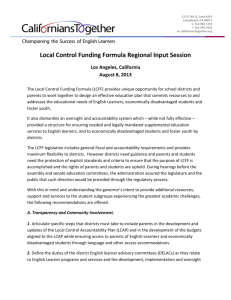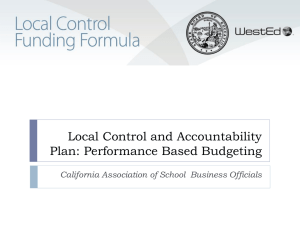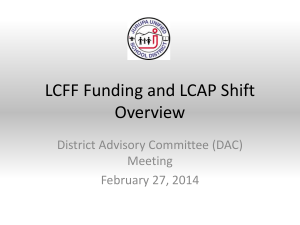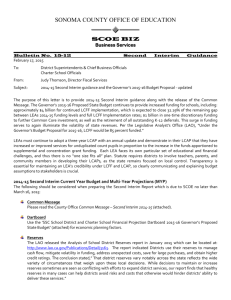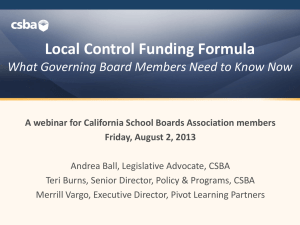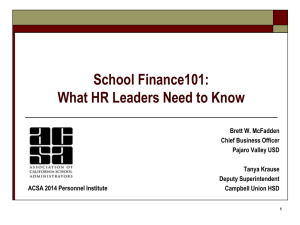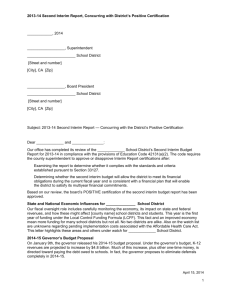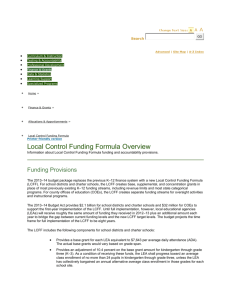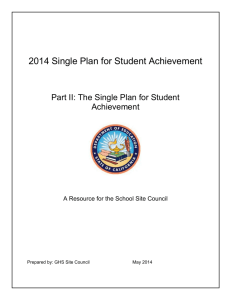3 - 2014-15 Adopted Budget Conditional Approval
advertisement
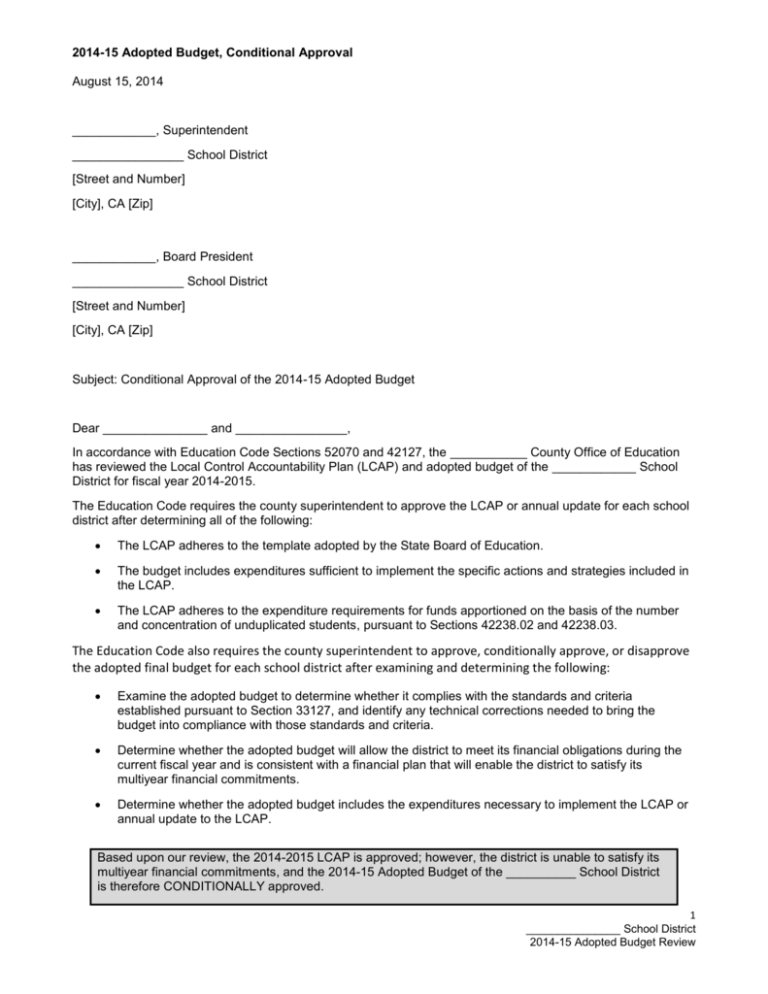
2014-15 Adopted Budget, Conditional Approval August 15, 2014 ____________, Superintendent ________________ School District [Street and Number] [City], CA [Zip] ____________, Board President ________________ School District [Street and Number] [City], CA [Zip] Subject: Conditional Approval of the 2014-15 Adopted Budget Dear _______________ and ________________, In accordance with Education Code Sections 52070 and 42127, the ___________ County Office of Education has reviewed the Local Control Accountability Plan (LCAP) and adopted budget of the ____________ School District for fiscal year 2014-2015. The Education Code requires the county superintendent to approve the LCAP or annual update for each school district after determining all of the following: The LCAP adheres to the template adopted by the State Board of Education. The budget includes expenditures sufficient to implement the specific actions and strategies included in the LCAP. The LCAP adheres to the expenditure requirements for funds apportioned on the basis of the number and concentration of unduplicated students, pursuant to Sections 42238.02 and 42238.03. The Education Code also requires the county superintendent to approve, conditionally approve, or disapprove the adopted final budget for each school district after examining and determining the following: Examine the adopted budget to determine whether it complies with the standards and criteria established pursuant to Section 33127, and identify any technical corrections needed to bring the budget into compliance with those standards and criteria. Determine whether the adopted budget will allow the district to meet its financial obligations during the current fiscal year and is consistent with a financial plan that will enable the district to satisfy its multiyear financial commitments. Determine whether the adopted budget includes the expenditures necessary to implement the LCAP or annual update to the LCAP. Based upon our review, the 2014-2015 LCAP is approved; however, the district is unable to satisfy its multiyear financial commitments, and the 2014-15 Adopted Budget of the __________ School District is therefore CONDITIONALLY approved. 1 _______________ School District 2014-15 Adopted Budget Review Conditional Approval Education Code 42127(c)(2) provides that the county superintendent of schools shall either conditionally approve or disapprove a budget that does not provide adequate assurance that the school district will meet its current and future obligations. The 2014-15 budget adopted by the ____________ School District does not meet this requirement. Our analysis reveals that in order for the _____________ County Office of Education to approve the _________________ School District’s 2014-2015 budget, the district will need to identify expenditure reductions sufficient to meet the required reserve in the current and two subsequent years. The specific conditions for this approval are: The necessary expenditure reductions shall be identified and adopted by the board for inclusion in the district’s budget and multiyear projection and submitted to the county superintendent on or before September 30, 2014. The county superintendent of schools is then required to approve or disapprove the revised budget no later than October 8, 2014. If the county superintendent is unable to approve the revised budget, the county superintendent of schools shall form a budget committee under the authority of Education Code 42127.1. Beyond and included with this conditional approval, the following analysis is provided: State and National Economic Influences for _____________ School District Through our fiscal oversight role we carefully monitor the economy, its impact on state and federal revenues, and how these might affect __________ County school districts and students. The 2014-15 state adopted budget includes a continued funding commitment toward the implementation of the Local Control Funding Formula (LCFF). This year also marks the first year of the LCFF’s accountability element through the Local Control Accountability Plan (LCAP), and its impact on local budgeting and planning. Also on the watch list are unknowns regarding pending implementation costs associated with the Affordable Health Care Act. This letter highlights these areas and others under watch for ____________ School District. 2014-15 State Budget Adoption On June 20, the governor signed the 2014-15 budget, committing $4.7 billion to implementation of the LCFF. This resulted in higher LCFF gap funding for state-funded districts. Basic aid districts continue their basic aid status protection under LCFF. An additional $4.7 billion was committed toward paying down the state’s K-12 revenues that have been deferred from one year to the next. If the state brings in additional revenues during the current year, the state will pay down the final balance of approximately $900 million in K-12 cash deferrals. The state budget includes provisions to begin addressing the unfunded pension liabilities at CalSTRS and CalPERS by including ongoing annual increases to the employer rate. The employer rate for CalSTRS will increase over the next seven years, reaching 19.10% in 2020-21. Likewise, the CalPERS rate is projected to increase slightly in 2014-15 to 11.771% and then continue increasing over the next seven years to reach an employer rate of 20.4% in 2020-21. These rate increases will increase personnel costs. Local Control Accountability Plan (LCAP) for _________ School District Under the LCFF, each district is required to adopt an LCAP, aligned with the state’s priorities, that identifies locally-developed goals, actions and expenditures aimed at outcomes for students. We commend the district’s efforts in developing its first LCAP during the 2013-14 school year. Additional information has been provided in a separate LCAP Review letter, also dated August 15, 2014. Local Control Funding Formula (LCFF) for ____________ School District The 2014-15 state budget shows a continued commitment to fully funding the LCFF; nonetheless, the LCFF has markedly different results for the individual districts in _________ County: For basic aid districts, including ___________ School District, the LCFF does not generate any additional revenue beyond the previously restricted categorical funding that has been subsumed into the LCFF. 2 _______________ School District 2014-15 Adopted Budget Review Student Attendance We note that the district’s adopted budget is based on an ongoing decline in average daily attendance (ADA), with an assumption that ADA will continue to decline over the multiyear projection. We note that the adopted budget includes an increase in staff despite the reduction in the number of students being served. Federal Sequestration Cuts Federal sequestration cuts refer to the automatic spending reduction triggered in the federal budget for fiscal year 2013. As a result of sequestration, districts realized an average 5.2% reduction in federal funding for the 2013-14 school year. The federal government has since taken action to restore most of the funding for education for fiscal year 2014, resulting in an estimated increase of at least 4% above fiscal year 2013 sequestration levels. Community-Funded Districts — Basic Aid The definition of community-funded districts has changed with the LCFF because all districts are guaranteed minimum state funding of at least the amount they received in 2012-13 for categorical funding. Communityfunded districts are commonly called “basic aid,” which refers to the basic aid entitlement for all students of $120 per Average Daily Attendance (ADA) as set forth in the California Constitution as defined in Education Code Section 41975. An additional constitutional guarantee is now provided through the passage of Proposition 30. Drafted as a means of guaranteeing benefit to all schools, Proposition 30’s Education Protection Act (EPA) provides that no school district shall receive less than $200 per ADA. Unlike the constitutional minimum set forth in Education Code Section 41975, however, EPA dollars are not ongoing and are set to expire in 2018-19. Property Tax Trends The final report of actual property taxes for 2013-14 shows an increase in taxes over the April 2014 estimate. A portion of the increased taxes is generated when properties are sold for a higher amount than their assessed value. The secured property roll for 2014-15 confirms the increase in assessed values and associated property taxes. The resulting property tax growth rate is a marked improvement relative to the last seven years. The county assessor estimates property taxes will grow by 3.64% in 2014-15. The following chart shows actual rates through 2013-14 and the district’s projection for 2014-15 through 2016-17. Property Tax Growth Rate 10.00% 8.64% 8.72% 8.00% 5.77% 5.52% 6.00% 2.10% 4.00% 2.05% 2.50% 2.50% 0.98% 2.00% -0.37% -1.16% 0.00% -2.00% 2006-2007 2007-2008 2008-2009 2009-2010 2010-2011 2011-12 2012-13 2013-14 PROJECTED PROJECTED PROJECTED 2014-15 2015-16 2016-17 Operating Deficits The district’s budget adoption projects operating deficits in the unrestricted general fund of $1.4 million for 201314, $1.5 million for 2014-15, $1.7 million for 2015-16, and $2 million for 2016-17. The cumulative effect of this projected deficit spending is that the fund balance will be completely exhausted and the district will report a negative ending balance of $0.6 million at June 30, 2017. Although some deficit spending may be a result of one-time costs from prior year funding sources, ongoing structural deficits threaten a school district's future educational programs. Districts that wait too long to address and correct structural deficits are forced to make dramatic corrections all at once. In contrast, carefully planned and phased-in structural corrections lessen the impact on children. 3 _______________ School District 2014-15 Adopted Budget Review Salary Settlements School districts are in the people business. On average, California school districts spend 90% of unrestricted dollars on salary-related costs. Salaries and benefits currently make up 83% of the district’s unrestricted expenditures. We note that the district has not settled negotiations with the classified bargaining units for 201314 or 2014-15. Because of the ongoing nature of these costs, any permanent increases to salary costs require permanent and ongoing funding sources. When the district and bargaining unit are ready to settle negotiations, Government Code 3547.5 requires the district to publicly disclose costs, as certified by the superintendent and chief fiscal officer, related to any bargaining agreement prior to the board of trustees’ approval. Please provide a disclosure of collective bargaining agreement, including the tentative agreement(s) and multiyear projection, to our office 10 working days prior to board approval. Cash Flow The district’s historical cash flow statements indicate that the district has sufficient cash throughout the year to meet operating expenditures without external cash borrowing. The district is well advised to maintain reserves at far higher levels than the state-required minimums to ensure sufficient cash for operating purposes. Parcel Taxes Your community has shown support for its schools through a parcel tax. The district’s multiyear projection includes parcel taxes in all three years, starting with a base of $0.9 million in the adopted budget restricted general fund. Retiree Health Benefits The district provides health benefits to retired employees (OPEB) who have met certain eligibility requirements. The district funds these benefits with the annual budget appropriation, paying as the expenditures come due. The district’s projected OPEB cost for 2014-15 is approximately $91,000 and the entire liability is $2 million. This measurement is based on the district’s actuarial study dated July 2013. We note that the district has established a special reserve in the amount of $112,000 to begin funding the OPEB liability. Reserves The district fails to maintain the state-required 4% minimum reserve for economic uncertainty in the current and two subsequent years. The district projects an ending balance of negative $630,000 at June 30, 2017. The 4% minimum required reserve for economic uncertainty is approximately $500,000, which means the district is $1.13 million short of the required reserve level at June 30, 2017. As discussed above under Conditional Approval, the district will need to identify expenditure reductions sufficient to meet the required reserve in both the current and two subsequent years before the adopted budget can be approved. Conclusion We thank ______________ for timely submission of the adopted budget using the statutorily required forms. If you have any questions, please do not hesitate to contact me at ___-___-____. We appreciate your dedication and service to the children of __________ County. Because of your good fiscal stewardship, the children of ___________ County will continue to experience quality education now and in the future. Sincerely, __________________ County Superintendent ___________________ Assistant Superintendent/Business Services 4 _______________ School District 2014-15 Adopted Budget Review cc: District ____________, Chief Business Official 5 _______________ School District 2014-15 Adopted Budget Review
